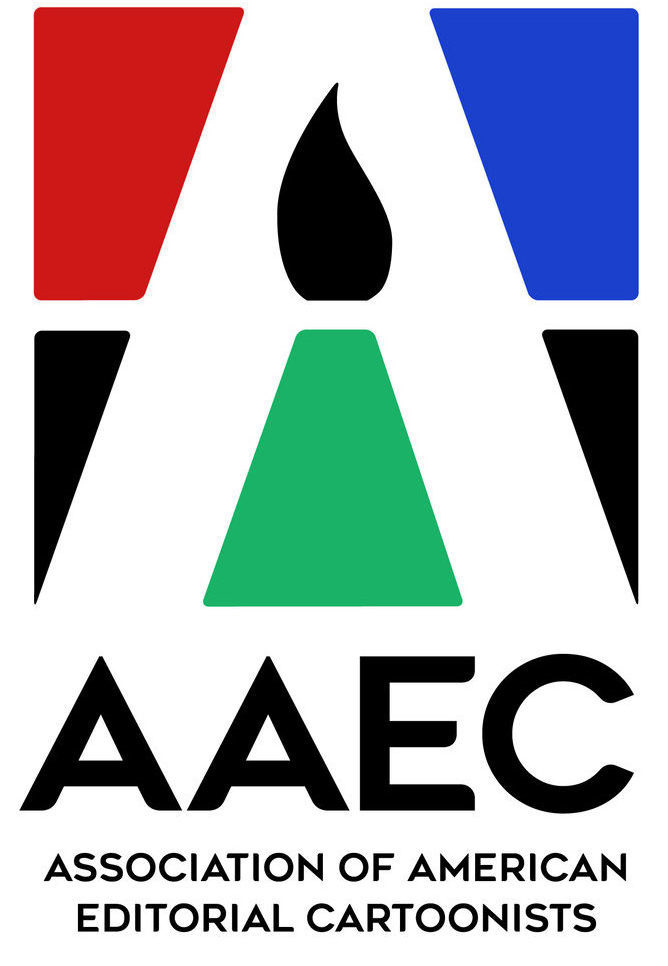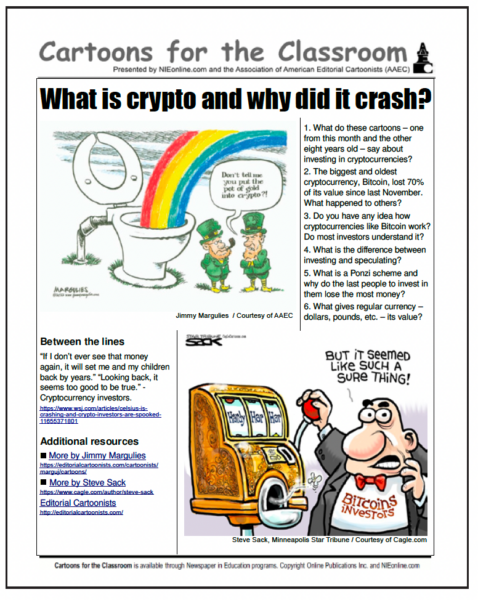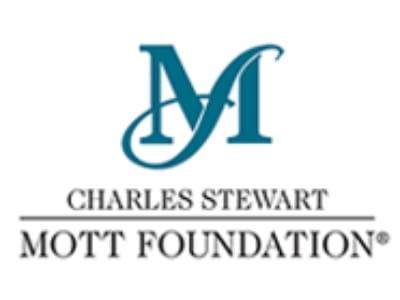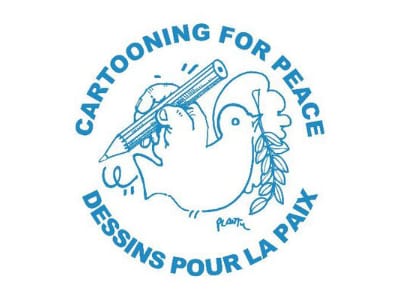by Angelo Lopez
In mid September I attended the 56th annual convention of the Association of American Editorial Cartoonists in Washington D.C. It was an enjoyable event and I managed to meet many cartoonists whose work I deeply admire. Two years ago I had attended an AAEC convention in Portland, Oregon, and had a good time. This year it seemed very appropriate for the convention to take place in our capitol as it is an election year. It was my first time in Washington D.C. and I had time to visit the great monuments and talk to other political cartoonists from across the country.
The convention kicked off on September 13 at the Library of Congress. We heard a discussion on the views of four esteemed political cartoonists on the upcoming Presidential elections of Barack Obama and Mitt Romney. Ted Rall of the Los Angeles Times and Lalo Alcarez of Pochco.com represented the left wing viewpoint while Steve Kelly of the New Orleans Times-Picayune and Scott Stantis of the Chicago Tribune represented the right wing view of the election. The panel discussion was open to the public and it was well attended, with over 60 people in attendance. Both the progressive and the conservative cartoonists were critical of Obama and Romney. Rall was deeply critical of Obama for his policies in Afganistan and his compromising too much to a recalcitrant Republican Congress, while Alcarez criticized Obama’s
immigration policies. Both Steve Kelly and Scott Stantis were critical of both Obama and the Congress for their failure to deal with the national debt. Stantis was also critical of Mitt Romney as being a waffler on important issues and he was deeply critical of the Super Pacs that seemed to be able to buy off elections with their money.
I enjoyed the clash of ideas in the discussion. One member of the audience asked a question that provided some of the most thoughtful responses. With the deep polarization of the American electorate, can cartoons be an avenue for people to be exposed to different points of view other than their own? Ted Rall noted that the Internet seems to be making things a lot more polarized, as people can look at sites that confirm their points of view. Rall tries always to bring something new to the discussion with his political cartoons and he wants to always be original. Scott Stantis noted that when he does a cartoon that tries to present both sides of an issue, he gets criticized by the Right. Stantis’ goal is to make people think when they see his cartoons. Alcarez said that as someone who was born in the border of the U.S. and Mexico, he wants his cartoons to always defend immigrant rights. He noted that laws may change, but humans are humans and always should be treated fairly. Steve Kelly said that readers need to read widely and be informed and be able to defend their point of view. For Kelly, it’s important an individual to develop his or her own point of view and not just blindly follow the views of their parents, their friends or their community.
After the Library of Congress, the group went to a Congressional hearing room, where we heard Republican House Whip Kevin McCarthy and Democratic Respresentative Jim McGovern of Massachussetts speak to the AAEC. Several cartoonists grilled Representative McCarthy with questions about the Republican efforts to supress certain voter groups that are taking place in swing states. Clay Bennett, Joel Pett, Ted Rall and a cartoonist named Pam (I didn’t catch her last name) peppered McCarthy about proposed laws that would have the effect of suppressing voters in minority, women and poor communities. Jack Ohman noted the lack of community in Congress and asked how the two Representatives have tried to get the two Parties to talk to each other. Nate Beeler asked the two Representatives their thoughts on the next four years if Obama wins the elections but the House remains dominated by the Republicans.
I enjoyed the several planned discussions, but I most enjoyed just meeting and talking to the various editorial cartoonists from around the country. During the past year, I had gotten into an exasperating conflict at a church, so I was feeling a bit depressed coming into this convention. So it was really gratifying to just meet some of my cartoonist heroes and listen in on conversations. I was a bit star struck when I’d meet a cartoonist whose work I have always admired and I kept getting brain freezes when I’d first encounter them. Holy cow, I’m talking to Clay Bennett! I just had breakfast with Lalo Alcaraz! I’m sitting four chairs from Tom Toles!
At my first day I had breakfast with Lalo Alcaraz, David Brown and Guy Badeaux, and we had an interesting conversation about receiving hostile emails from readers and about the need for more political cartoonists of color. I listened in on a conversation between Ted Rall and Tom Tomorrow about the state of alternative political cartooning. I didn’t know anything about any of those subjects, so I learned a lot from listening.
At another breakfast I asked Guy Badeaux his advice about a situation I sometimes get into while cartooning for the Philippines Today. I’ve been cartooning for about a year now for the Philippines Today, and though I’m a Filipino American, I’m still learning about issues pertaining to the Philippines and the Filipino American community. Sometimes some important news occurs in the Philippines or the Filipino American community that I have no knowledge or opinion about, and I don’t really have time to do much research on. When I don’t have a strong opinion on something, I have a hard time thinking up any good ideas for a cartoon. Since it’s big news in the Philippines, though, I feel this need to do a cartoon on it. Guy told me that sometimes a cartoonist can know too much about an issue, and he can wind up doing a cartoon that the average reader won’t have enough information to understand the cartoon. Sometimes it’s best just to skip a certain subject for other equally important but less publicized subjects that I’m more knowleadgable about.
At a panel with Matt Bors and Susie Cagle on comics journalism, a member of the audience asked a question of Cagle that had particular interest to me. Cagle had covered the Occupy Oakland protests and was arrested while in the middle of a protest. The audience member asked Cagle if she considered herself an observer of the protests or whether she considered herself a participant in the protests, and how would this affect her as a disinterested journalist. The question interested me, as I participated in the local Occupy San Jose and Occupy Mountain View events in my area, and I had attend various rallies and protests in the past 3 years. If Cagle was a participant in the protests, why would that be bad? I was too shy to ask about this, but I thought about it later. I had read in Jules Feiffer’s memoir that he had participated in a few protests during the 1960s while working for the Village Voice. Many of the great radical cartoonists of the early twentieth century, like Art Young, Boardman Robinson, and Robert Minor, had participated in workers’ rallies, socialist meetings and political protests. After thinking about it for a while, I have this theory that there may be a difference between editorial cartoonists who work in major newspapers and political cartoonists who work in alternative newspapers or advocacy periodicals. It seems that editorial cartoonists in major newspapers view themselves as journalists and work within the boundaries of journalistic ethics. Cartoonists like Feiffer, Young, and Robinson may have seen themselves foremost as political activists who see their political cartoons as another form of political activism to go with protests and acts of civil disobedience. I don’t know how accurate my theory is, but I may ask some cartoonists about it when I attend my next convention.
I spent most of my time hanging around those political cartoonists who, like myself, work fulltime at a noncartooning job and do their editorial cartoons on the side. We all admired those cartoonists who were able to ply their trade fulltime at a major newspaper or were able to earn their money from alternative newspapers. During lunch breaks, we would talk about our favorite points from the speakers at the various talks and see how that could apply to our own situations. It was fun just to talk to other cartoonists about cartooning. One of the things with me is that I go through periods where I come up with several good cartoons in a row, then I go through a dry spell where I’m not really satisfied with any of the cartoons that I’m producing. In talking to other cartoonists, they also mentioned that they also went through frustrating dry spells. One evening a group got together to shoot pool and play ping pong and I had a great time. In all these conversations and sharing, I made some good friends.
The foreign cartoonists were an interesting lot. The Uzbekistan cartoonists were very friendly, but it was frustrating at first trying to talk to them, as they didn’t understand English. They were followed by two really nice translators, and I had a chance to joke around with them. I didn’t get much of a chance to talk to the Middle Eastern cartoonists, but I wish I had. I wanted to ask them about their thoughts on the Arab Spring. With the recent protests in the Middle East due to the Youtube video, they would’ve been able to provide some good insights to help understand the situation there.
The panel talks were very enlightening. The panel comprised of Steve Brodner, Nick Anderson, Ann Telnaes and Mark Fiore did a very good presentation on animated political cartoons. Brodner noted that the decrease in the number of newspapers makes finding new avenues for political cartoons necessary. One of the strongest impressions I got from each cartoonist is that none of them like working in the Flash animation program.
Matt Bors and Susie Cagle did a good talk on comics journalism. Bors talked about his work as editor in the Cartoon Movement, a political cartoon website based in the Netherlands. As editor, Bors fact-checks the comics that come his way, and has recently worked with a cartoonist in Haiti to cover the situation in that country. Cagle has done several good cartoons on the Occupy Oakland protests, the history of the Bay-To-Breakers, Faith Based Pregnancy Centers in the San Francisco Bay Area, and the medical marijuana issue. Cagle uses the “Thing link” site to upload images and put links to audio or video, which adds an exciting new element to her cartoons.
Two panels showed cartoons from a left wing and a right wing point of view. Clay Bennett, Tom Tomorrow and Jen Sorensen showed cartoons from a left wing point of view, while Chip Bok, Scott Stantis and Nate Beeler showed cartoons from a right wing point of view. Both groups were very good. I am biased towards a more liberal view on things, but I found Bok, Stantis and Beeler to be just as informative, and thoughtful in their cartoons. The common thread of the three conservative cartoonists was their concern about the national debt.
Jack Ohman talked about the passing of the generation of cartoonists who were influenced by Jeff McNelly and Pat Oliphant. As a youth, Ohman was influenced by James Thurber and the New Yorker, and he’s lately been returning to his roots, doing multi-panel comics that have really satisfied Ohman with their artistic challenges.
Lalo Alcaraz showed the cartoons on immigration that he has been doing since 1994. Clay Bennett talked about his experiences as a liberal cartoonist working in a conservative state. Tom Toles did a funny talk on the five secrets of good political cartooning. Pat Bagley talked about the depictions of Mormons by political cartoonists throughout history, while Gustavo Rodriquez talked about his transition from doing Cuban political cartoons to doing American political cartoons. David Horsey, Brian McFadden, Ben Sargent, Jen Sorensen, John Cole, Kevin Kallagher and Patrick Chappatte also had informative talks. In the evening, Jack Ohman gave a moving memorial on the life of cartoonist Rex Babin.
The most inspirational moment of the evening was when the The Cartoonists Rights Network International awarded Ali Ferzat of Syria, and Aseem Trivedi of India, the Courage in Cartooning Award for 2012. Ali Ferzat’s cartoons confronted the Syrian regime’s increasing brutality against the democracy movement and he lampooned President Bashar Assad. In retaliation, thugs brutally beat Ali up, intentionally breaking both his hands. Aseem Trivedi, a young cartoonist from India, launched the Cartoons Against Corruption website to mobilize his fellow citizens against India’s pervasive political corruption. The Indian government charged Trivedi with treason and insulting national symbols, and he is in imminent danger of being jailed.
I probably won’t go to next year’s AAEC convention, but I hope to attend the convention in two years. I have to save up the money. It was a very enriching experience for me to attend this year’s AAEC convention, and I learned a lot. It inspired me to try to constantly improve my cartoons and to challenge the readers on important issues. This was only my second convention, so I have no comparison to how this convention compares to past conventions. But I think Matt Wuerker and John Coles did a good job. I hope the editorial cartooning profession survives in the U.S. as I think we provide a needed forum for dissent and discussion on important political issues.












